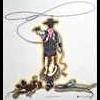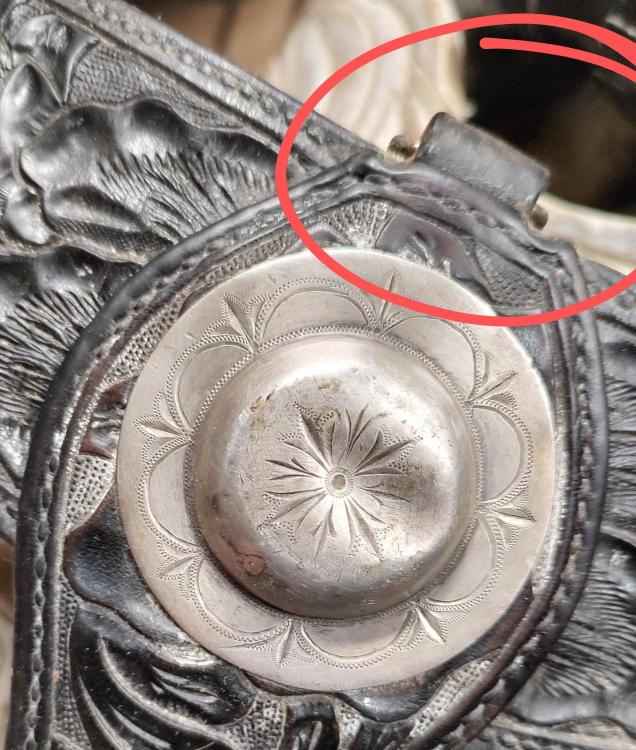
Wenny
Members-
Posts
38 -
Joined
-
Last visited
Contact Methods
-
Website URL
http://wennymakesit.blogspot.com/
Profile Information
-
Location
United States
-
Interests
Maintaining and repairing vintage horse tack, especially western, and learning to make saddles.
LW Info
-
Leatherwork Specialty
Repairs and restoration
-
Interested in learning about
Everything!
-
How did you find leatherworker.net?
Google search
Recent Profile Visitors
3,134 profile views
Wenny's Achievements

Member (2/4)
-
Got a breastcollar from the 1940s that has a 1" square ring at the top of the chestpiece. Found two similar rings on breastcollars in a 1942 Hamely catalog. The description in the catalog said "for attaching a lead-up strap". Nobody would lead a horse by attaching a strap to their chest, I figure, so it can't be for that. I've seen short forks/training forks/martingales attached to breastcollars in similar ways, but I've never heard those called a lead-up strap. Is it just another name for a fork? Or is a lead-up strap a whole different a piece of cowboy gear? (click pic to embiggen)
-
I thinned Titebond Hide Glue with water (1:2 like bucksnort recommended) in a shallow dish, then dunked the bosalita in and swished it around to make sure it covered the surface and got in all the books and crannies. I brushed off the extra glue so it wasn't dripping, then hung the bosalita to dry over a chunk of wood to give it the right shape. Even after drying for only a few hours, there's already a noticeable difference in the feel of it; not floppy at all, and a bit of spring. After it cures for the 24 hours advised on the bottle, I think I'll have a dandy piece that's ready to go back to work! Now watch out as I hit all the tack sales buying beat up rawhide gear bargains!
-
Sounds good! So do I saturate/soak it, or just brush it on the surface? Thanks for the help.
-
I picked up an old bosalita/pencil bosal at a yard sale. It's a decent piece of braidwork, but it's gotten soft with use. Is there anyway I can get some life and spring back into this soft rawhide? Would soaking it in water and letting it dry do the trick? I got it cheap, so I'm willing to experiment.
-
Because of the short strings, I believe the fifth concho was purely decorative. Here's a pic of the clean-up, and no, I didn't use a hose! Need to refleece the skirts, re-cover the horn, put on a new cantle roll, cut some new strings and put the lot back together. No rush.
-
Do Gooder Heavily Oiled Roughout Roper
Wenny replied to Saddlebag's topic in Saddle Identification, Restoration & Repair
I'm guessing that what you're talking about is a rough-out saddle that's been oiled by someone to the point that the leather is greasy and slick, and you want to get rid of some of the oil. I'd give it a wash or two with plain old Ivory dish soap. That should take off some of the oil. As it gets dry, brush up the nap on the rough-out with a nail brush or similar. A dab of light conditioner like Lexol on the skin side, and call it good. If you're dealing with rough-out that has been slicked over time with lots of riding, the wash and brush might not be enough. I've used gently-applied coarse sandpaper and a brass brush to scuff up slicked suede/rough-out before with some success. -
Help With Recondition
Wenny replied to greyhawk's topic in Saddle Identification, Restoration & Repair
I cut 1/2" strips of latigo leather to make my own saddle strings. If you have to replace missing conchos, just stay as close to the style of the original ones as you can. There are some fancy conchos out there, but they won't look right on a historical saddle. -
Help With Recondition
Wenny replied to greyhawk's topic in Saddle Identification, Restoration & Repair
Richard Sherer has a lot of good information on his website and in his articles. Check him out here http://www.sherersaddlesinc.com/ . And of course you should take a look at the fantastic book by Alain Oin. Here's a link to more on him and his book. http://www.thereenactors.com/community-news/196/vintage-western-saddle-restoration-tips-from-alain-eon-author-and-craftsman -
Help With Recondition
Wenny replied to greyhawk's topic in Saddle Identification, Restoration & Repair
Your first step is to clean it. You need to get all the dirt and salts off the surface or any conditioner you put on it will just pull the filth into the leather. Use a pH balanced soap like Lexol and as little water as possible. Don't get it soaking wet! These old saddles often had a coat of shellac or similar sealant put on them, and that will make it difficult for conditioner to get into the leather, so it's got to go. It shows up as a grey, alligator-scale-looking haze. You can use Fiebing's Dye Prep to remove it, or mix up this cleaner. (Recipe courtesy of Richard Sherer) 1 part Ivory Concentrated Dishwashing Liquid detergent: 2 parts household ammonia: 1 Part water. It stinks like the dickens, but it'll take off the old finish. Scrub gently with a soft toothbrush and again, just enough water to rinse it off. I use a damp sponge. Then let it dry. Give it a day or two. Don't try to hurry things by putting it in direct sunlight or by a heater, just let it rest. You'll know it's dry when it's stiff and light brown in color. Apply your conditioner. Fiebings is a good one. I like lotion-y ones like Blackrock better than greasy ones. I think they sink in better, but there are many good ones and you'll probably get lots of recommendations here. Apply a light layer of conditioner every other day or so until the leather starts to feel right. Above all, take your time and do it right. When I'm done cleaning and conditioning, I like to put a topcoat of Tan-Kote water-soluble finish on, to give it a nice warm shine. Don't use anything with " -Lac" in the name (Saddle-Lac, for example); it will seal the leather and won't let it breathe like Tan-Kote does. I'd love to see pictures of your finished project! -
Anyone here an expert on Visalia maker stamps? I've picked up a loop seat stock saddle and I'm trying to figure out when it was made. The stamp on the seat rise is in an oval and reads "D.E. Walker, Maker, Visalia, Cal." It does NOT have the "Trade Mark" above and below this stamp. The stamp on the cantle back says "Visalia Stock Saddle Company, Makers, San Francisco, Cal." There is no serial number. On the skirt under the near side rigging, the word "Plain" (or something similar) is handwritten. As the saddle is extensively tooled, I doubt this was a note about the style. A maker's signature, perhaps, or of a former owner. The high cantle, loop seat, and center-fire rigging are trends that place it in the range of 1880-1920, but I'd like to narrow that down a little. The tooling is a cut-in floral pattern with very little shading which I think points to the earlier end of the scale. Here are some pictures. What do you experts think?
-
I made a four hour road trip yesterday to pick up this Visalia loop seat stock saddle from an old buckaroo. It looks rough now, but all the original parts are there, even the latigo keeper, and I think it's going to clean up nicely. The only repairs I have found that need to be made are a new horn covering, skirt lacing behind the cantle, and new strings. Oh, and of course new fleece. I'll be hauling out the books to start my research this afternoon, but for now -- what do you think, did I make a bargain? I paid only $75.
-
How do you decide if a saddle is worth restoring? I mean, if it's a well-known maker, has historical significance, belonged to someone famous/infamous, has sentimental value-- these are all good reasons. But what about the ones you find at barn auctions, or are handed to you by someone who "heard you like old saddles"? What do you take into account to decide if a project saddle is worth your time? How do you evaluate condition? What are deal-breakers?
-
How To Restore This Color?
Wenny replied to SlippedBuck's topic in Saddle Identification, Restoration & Repair
After you clean and condition it, take a piece of soft toweling or fleece and rub a light finish of Tan Kote on it. (Available from Tandy leather) Tan Kote is a water-based finish that will give your saddle a nice soft shine. It will come off the next time you clean your saddle, so you can condition your saddle as usual and then reapply the Tan Kote. It smells nice, too! Do NOT use Saddle-Lac, Lac-Kote, or anything with "lac" in the name-- that's lacquer and it will seal the leather making it impossible to condition in the future. -
Picked up this poor old thing for $20 off Craigslist. It's dry, filthy, and worn. Stamp on the jockey corner says "Great West Sadd..." with the rest worn away. That and the loop seat places it around 1900 in Calgary, Alberta. I know the fenders aren't original. They're not the right style, and they're actually in pretty good shape. The rest of the saddle, Hmm. Well, it's not gonna win any prizes. What's interesting to me about it is that fifth concho on the skirt. Never seen one of those placed like that before. Thought I'd share it here for y'all to take a look at. Here's the picture that was with the ad. I even got the metal stand along with the saddle for my $20. Here you can see that extra concho down in the corner. Here's the rigging, which was probably redone the same time as the stirrup leathers/fenders.
-
Help To Identify And Restore Antique Saddle
Wenny replied to MareK's topic in Saddle Identification, Restoration & Repair
New rigging for a McClellan should be a pretty easy fix; after all, it's just straps, really. The important thing is to make sure those straps are hanging equally. If one is even a little forward of the one on the other side, the saddle will ride unevenly, causing it to shift off balance on your horse's back, making him uncomfortable. This can cause soring, back issues, and attitude problems in the horse. It'd be like you walking all day carrying a heavy backpack with only one strap. You're really enthusiastic about saddles! If you haven't already, you should start hanging around tack shops and looking at the way different saddles are rigged. Talk to the people there, and if there is a saddlemaker on site, ask their advice. Some things are best learned hands-on, other things take specialized tools, and having someone experienced to talk things through with is a real help. Good luck!












